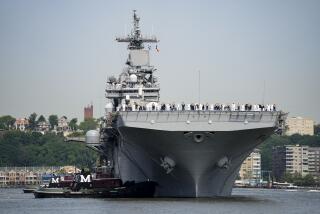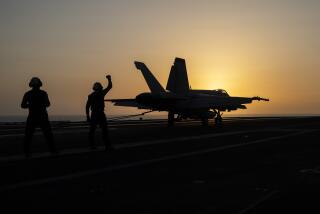Submarines Join Assault; New Missile Passes 1st Test
ABOARD THE USS JOHN F. KENNEDY IN THE RED SEA — The U.S. Navy has launched cruise missiles at Iraq from submarines in the Red Sea and fired a new remote-controlled missile in combat for the first time.
Rear Adm. Riley Mixson, commander of the 30-strong Red Sea battle force, told reporters Monday that the warships have fired more than 40 Tomahawk cruise missiles since the Gulf War began Thursday.
Some came from submarines, but he did not say how many or name the ships.
The Tomahawks have proven to be among the most effective in the latest generation of high-tech weapons going through combat trials in the gulf.
The other new weapon, known as the SLAM or “standoff land attack missile,” was fired in action for the first time Saturday by the pilot of an A-6 Intruder operating from the aircraft carrier Saratoga.
The first two of the missiles, which have pinpoint accuracy up to 60 miles, were aimed at what Mixson called “a very important target--I would classify it as a well-defended industrial-type activity.”
A videotape recording, transmitted from the nose of the missile as it approached the target, showed a complex of buildings.
The missile crawled over a number of outlying structures, homing in on a large building that it was programmed to attack. Ladders and windows were clearly visible until the missile hit the wall and the transmission ended.
“My eyes were as big as saucers watching the second missile go into the first hole,” said the pilot who guided them both. He asked not to be identified for security reasons.
It takes two planes to operate the SLAM--an A-6 to fire it and an A-7 in which the pilot adjusts its flight path as it travels.
The captain of the Kennedy aircraft carrier, Capt. John Gay, said pilots started to demand standoff technology after their experiences in Vietnam, where many were peppered by antiaircraft fire.
The missile has a smaller payload than a conventional bomb, but its accuracy more than compensates for that failing, pilots said. The accuracy also minimizes collateral damage--military jargon for death and injury to civilians.
More to Read
Sign up for Essential California
The most important California stories and recommendations in your inbox every morning.
You may occasionally receive promotional content from the Los Angeles Times.









